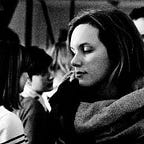Jour 2
Chapitre 3 : Quesadilla de queso fundido con chapulines
«Tienes algo para comer?» qu’on demande au serveur avec des rastas en recevant nos verres de mezcal et nos bières Pacifico et Leon Negra. Nous sommes dans un bar du quartier Centro Historico, pas très loin du musée où se tient Muséomix MX. Il est environ 20h30, on est pas mal brûlés, mais déterminés à goûter à la vie nocturne mexicaine. C’est vendredi soir, après tout.
L’assiette arrive quelques minutes plus tard. L’endroit est petit et branché, la carte ne compte qu’un seul plat : une quesadilla de fromage fondu aux chapulines, accompagné de frijoles et de nopal. Pour info, des chapulines, c’est des sauterelles.
Xavier goûte le premier, ça a un goût fumé et c’est croustillant, il aime bien.
Valérie en est encore à se tremper le bout des lèvres dans son petit shooter de mezcal, à boire très lentement en respirant profondément tel qu’expliqué par le serveur aux rastas. Ça ne rentre pas facilement. On recommande des tranches d’oranges avec du sel et du chile, pour mieux faire passer le tout.
Finalement, Xavier mange l’assiette à lui seul. En tout, il doit avoir manger une trentaine de sauterelles.
Il y a comme une honte à ne pas aimer certains éléments de la bouffe locale. Valérie se sent comme une très mauvaise touriste en ne mangeant pas de sauterelles, et en laissant son verre de mezcal a moitié plein.
C’est pas grave, on a encore plusieurs jours pour sortir des sentiers battus en terme de bouffe mexicaine.
Quand même, on fini la soirée avec des tacos de carne et on se régale.
Chapulines 1 — Valérie 0
Chapitre 4: The new design and creative class of Mexico City, with Lorenzo Alvarez
The building where Lorenzo Alvarez works was designed by his grandfather. The architect has chosen to establish his office at the 31st floor, right over a 2 floors coworking space he has cofounded.
Since the financial center of the city has moved to La Reforma in the 80s, the building rental space market and the target public of the real estate became obsolete. To answer that problem, Lorenzo tries to convince the owner that it would be better to encourage creative industries into renting the free spaces. To move faster, and also motivated by the legacy of his grandfather, he creates Archipiélago, a members only coworking space.
Lorenzo Alvarez is now trying to scale up a 3-years-old design festival he also cofounded, the Abierto Mexicano de Diseno. We talked with him about his conception of Mexican design and its role in solving local problems.
A design festival to promote a problem solving culture
From day 1 of Abierto Mexicano de Diseno, Lorenzo Alvarez wanted to bring design to the great public : ‘’It’s not a niche event. It’s not a design festival for designers, it’s for the grand public. We wanted to create this platform because we knew that there is a very vibrant scene of design but we lack in showing the works right here in the city. The platform is organic and open source, you can truly do whatever you want, there are students, important designers, brands, institutions, museums, schools, universities, government, and more.’’
The festival is also about public spaces and installations. The objective is for people to encounter design and get involve with the works. The organizers bring international designers to design these pieces. The 2015 edition, which took place in October, was under the thematic SOLUCIONES.
‘’I think looking for solutions is a inner component of design in general, but in Mexico we see a potential of design as a tool for solving problems of our country. We have big differences in income capabilities, social and economical problems. We still have gaps to fill and design is a tool to solve that. It’s a concern for Mexican designers’’, explains Lorenzo.
Design is sensitive, art is more rigid
Lorenzo Alvarez thinks that right now is really exciting time in Mexico for designers.
‘’One component is the fact that we tend to jump very quickly into doing things, and this is very exciting even for people who prototype and then iterate and do things very quickly. I would also say that what is inerrant to Mexican design is our sense of humor. We jump from bringing humor and being very serious, and it works in trying to do things quickly’’, he tells.
As a professional architect, Lorenzo finds in design a way to read culture : ‘’I think it comes from excitement from my profession, design makes me crazy everyday to make things, I have a desire to share it. I would like everybody to have a feeling of what design is for me. This is my gut feeling.’’
For him, design is a way of channeling his social views and to bring democracy for more people : ‘’It’s not only a tool to change material life, but it is also a tool to read culture. It’s a clear way to understand a place culturally.’’
To Lorenzo, design is what art was before. He feels it is nowadays more accurate in terms of understanding artistic, cultural, economic and social aspects of a culture.
Chapitre 5: Un esprit sain dans un corps sain
Au couché du soleil, on a observé de loin un groupe de jeunes gens pratiquant le nunchaku. Il y en a un qui n’avait pas son uniforme et qui semblait plus conscient d’être observé.
Publié à l’origine sur jetlagdiary.club
